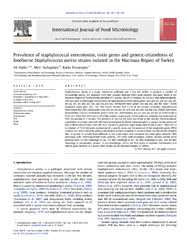Please use this identifier to cite or link to this item:
https://hdl.handle.net/11147/4982Full metadata record
| DC Field | Value | Language |
|---|---|---|
| dc.contributor.author | Aydın, Ali | - |
| dc.contributor.author | Sudağıdan, Mert | - |
| dc.contributor.author | Muratoğlu, Karlo | - |
| dc.date.accessioned | 2017-03-06T12:19:53Z | |
| dc.date.available | 2017-03-06T12:19:53Z | |
| dc.date.issued | 2011-08 | |
| dc.identifier.citation | Aydın, A., Sudağıdan, M., and Muratoğlu, K. (2011). Prevalence of staphylococcal enterotoxins, toxin genes and genetic-relatedness of foodborne Staphylococcus aureus strains isolated in the Marmara Region of Turkey. International Journal of Food Microbiology, 148(2), 99-106. doi:10.1016/j.ijfoodmicro.2011.05.007 | en_US |
| dc.identifier.issn | 0168-1605 | |
| dc.identifier.issn | 0168-1605 | - |
| dc.identifier.uri | http://doi.org/10.1016/j.ijfoodmicro.2011.05.007 | |
| dc.identifier.uri | http://hdl.handle.net/11147/4982 | |
| dc.description.abstract | Staphylococcus aureus is a major foodborne pathogen and it has the ability to produce a number of extracellular toxins. We analyzed 1070 food samples obtained from retail markets and dairy farms in the Marmara Region of Turkey for the presence of S. aureus. Out of 147 isolates, 92 (62.6%) were enterotoxigenic. PCR was used to investigate the presence of staphylococcal enterotoxin genes (sea, seb, sec, sed, see, seg, seh, sei, sej, sek, sel, sem, sen, seo, sep, seq and seu), exfoliative toxin genes (eta and etb) and the toxic - shock syndrome toxin gene (tst). The PCR results showed that 53.3% of the isolates contained staphylococcal enterotoxin-like (SEl) toxin genes (seg, seh, sei, sej, sek, sel, sem, sen, seo, sep, seq and seu) which were more frequent than classical enterotoxin genes (sea to see). Furthermore, seo, sei, sem, seg, seu and sec were found in 37.0, 32.7, 30.4, 29.3, 29.3 and 27.2% of the isolates, respectively. The tst gene was detected and confirmed by DNA sequencing in 9 isolates. The presence of eta and etb were not found in the isolates. Enterotoxigenic capabilities of isolates with SEA-SEE were investigated by ELISA. Enterotoxigenic S. aureus isolates produced one to three enterotoxins, with the most frequently produced types being enterotoxin A and C. There was a correlation of 72.1% between production of a specific toxin and the presence of the respective genes. PFGE analysis was used to identify genetic-relatedness of enterotoxigenic S. aureus isolates and the results revealed that 13 groups of isolates from different or the same origin that contained the same genes showed 100% homology with indistinguishable band patterns. The other enterotoxigenic isolates showed related band patterns with 72-86% homology in sea-, 61-90% homology in sec-, 80-96% homology in seh-, and 69-96% homology in sep-positive isolates. To our knowledge, this is the first study to examine enterotoxins and related gene contents of S. aureus food isolates in the Marmara Region of Turkey. | en_US |
| dc.description.sponsorship | Scientific and Technological Research Council of Turkey (107T266); Istanbul University (UDP-3645/13042009) | en_US |
| dc.language.iso | en | en_US |
| dc.publisher | Elsevier Ltd. | en_US |
| dc.relation.ispartof | International Journal of Food Microbiology | en_US |
| dc.rights | info:eu-repo/semantics/openAccess | en_US |
| dc.subject | PCR | |
| dc.subject | ELISA | en_US |
| dc.subject | Enterotoxin genes | en_US |
| dc.subject | Enterotoxins | en_US |
| dc.subject | PFGE | en_US |
| dc.subject | Staphylococcus aureus | en_US |
| dc.title | Prevalence of staphylococcal enterotoxins, toxin genes and genetic-relatedness of foodborne Staphylococcus aureus strains isolated in the Marmara Region of Turkey | en_US |
| dc.type | Article | en_US |
| dc.institutionauthor | Sudağıdan, Mert | - |
| dc.department | İzmir Institute of Technology. Biotechnology and Bioengineering Research and Application Center (IZTECH BIYOMER) | en_US |
| dc.identifier.volume | 148 | en_US |
| dc.identifier.issue | 2 | en_US |
| dc.identifier.startpage | 99 | en_US |
| dc.identifier.endpage | 106 | en_US |
| dc.identifier.wos | WOS:000293108400005 | en_US |
| dc.identifier.scopus | 2-s2.0-79959508145 | en_US |
| dc.relation.publicationcategory | Makale - Uluslararası Hakemli Dergi - Kurum Öğretim Elemanı | en_US |
| dc.identifier.doi | 10.1016/j.ijfoodmicro.2011.05.007 | - |
| dc.identifier.pmid | 21652103 | en_US |
| dc.relation.doi | 10.1016/j.ijfoodmicro.2011.05.007 | en_US |
| dc.coverage.doi | 10.1016/j.ijfoodmicro.2011.05.007 | en_US |
| dc.identifier.wosquality | Q1 | - |
| dc.identifier.scopusquality | N/A | - |
| dc.identifier.wosqualityttp | Top10% | en_US |
| item.languageiso639-1 | en | - |
| item.fulltext | With Fulltext | - |
| item.openairecristype | http://purl.org/coar/resource_type/c_18cf | - |
| item.openairetype | Article | - |
| item.grantfulltext | open | - |
| item.cerifentitytype | Publications | - |
| Appears in Collections: | IZTECH Research Centers Collection / İYTE Araştırma Merkezleri Koleksiyonu PubMed İndeksli Yayınlar Koleksiyonu / PubMed Indexed Publications Collection Scopus İndeksli Yayınlar Koleksiyonu / Scopus Indexed Publications Collection WoS İndeksli Yayınlar Koleksiyonu / WoS Indexed Publications Collection | |
CORE Recommender
SCOPUSTM
Citations
118
checked on Jul 27, 2024
WEB OF SCIENCETM
Citations
99
checked on Jul 27, 2024
Page view(s)
336
checked on Jul 22, 2024
Download(s)
642
checked on Jul 22, 2024
Google ScholarTM
Check
Altmetric
Items in GCRIS Repository are protected by copyright, with all rights reserved, unless otherwise indicated.
